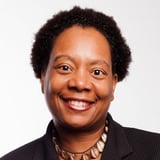Summary
Accessibility is about people with disabilities being able to fully participate as producers, contributors, and consumers of the digital world. And so of course that includes participating in the AI innovation boom. Fable’s Accessibility Strategist Amber Knabl will cover the recent innovations and opportunities we’re seeing that improve digital accessibility, and offer insight on how product teams can do better.
Key Insights
-
•
Designing for one person with a disability often creates solutions that benefit many users, including those with situational or temporary limitations.
-
•
Features like captions, dark mode, voice-to-text, and autocomplete originated as accessibility aids but are now widely used by billions.
-
•
Only 19% of surveyed users find existing AI trustworthy, revealing a significant gap in inclusive AI design and data representation.
-
•
AI-driven technologies such as image description apps and data graph interpreters hold promise for accessibility enhancements.
-
•
Bias in AI datasets often excludes people with disabilities, leading to inaccurate representations and diminished trust.
-
•
Inclusive product development requires co-design from the earliest stages, not only feedback after products are built.
-
•
Fable’s Accessible Usability Scale (OZ) adapts traditional usability metrics to better reflect assistive technology user experiences.
-
•
Engaging people with disabilities throughout the product lifecycle boosts team empathy, creativity, and confidence in fixing accessibility issues.
-
•
AI should be treated as a tool within accessibility practice, not as a standalone solution that replaces human input.
-
•
Recruitment of people with disabilities as testers and contributors is essential to creating trustworthy, inclusive AI and digital products.
Notable Quotes
"If implemented correctly, AI could have impressively positive impacts on inclusion and accessibility."
"I found myself sitting in the street as the traffic light turned green, blocked by a non sentient being incapable of understanding the consequences of its actions."
"Design for one extent to many is Microsoft’s inclusive design motto that guides effective accessibility."
"85% of Netflix users opt for captions, showing how accessibility features benefit everyone, not just those with disabilities."
"People with disabilities must be involved as producers, contributors, and consumers throughout the digital creation process."
"AI is currently automating and amplifying human biases that exist in society today."
"You don’t have to wait until an idea is fully baked to get feedback from assistive technology users."
"It’s way more cost effective to catch accessibility issues during the design phase than after shipping a product."
"Fable’s OZ adapts the System Usability Scale to better measure perceived usability for assistive technology users."
"AI should remain a tool, not a standalone solution, in inclusive product development."
Or choose a question:
















More Videos

"Good design is good business."
Doug PowellClosing Keynote: Design at Scale
November 8, 2018

"Recruiting kids really means recruiting adults as their proxies and gatekeepers."
Mila Kuznetsova Lucy DentonHow Lessons Learned from Our Youngest Users Can Help Us Evolve our Practices
March 9, 2022

"Evan actually spent less than 15 minutes on the essay, and instead of working on homework, he was writing a letter to his significant other back home in Detroit."
Sarah GallimoreInspire Progress with Artifacts from the Future
November 18, 2022

"If your users are happy, that anecdotal feedback often carries more weight early than quantitative metrics."
Lada Gorlenko Sharbani Dhar Sébastien Malo Rob Mitzel Ivana Ng Michal Anne RogondinoTheme 1: Discussion
January 8, 2024

"Our goal is to be AI fluent, not necessarily AI experts."
Alnie FigueroaThe Future of Design Operations: Transforming Our Craft
September 10, 2025

"If you measure an infinite number of customers, every change would be statistically significant, but not every change would be meaningful."
Landon BarnesAre My Research Findings Actually Meaningful?
March 10, 2022

"When you encounter an obstacle, how do you respond? Maybe it’s an invitation to grow."
Emily EagleCan't Rewind: Radio and Retail
June 3, 2019

"Managing resistance is mental; customers might resist because they've learned workarounds with legacy systems."
Malini RaoLessons Learned from a 4-year Product Re-platforming Journey
June 9, 2021

"Project management was focused on outputs, assuming the correct feature was already defined."
Asia HoePartnering with Product: A Journey from Junior to Senior Design
November 29, 2023
Latest Books All books
Dig deeper with the Rosenbot
How do newer generations of law students view the incorporation of UX principles into legal education?
What steps can help scale service design conversations and practices across diverse media organizations?
How can metrics like the Accessible Usability Scale be used post-launch to improve accessibility?
















